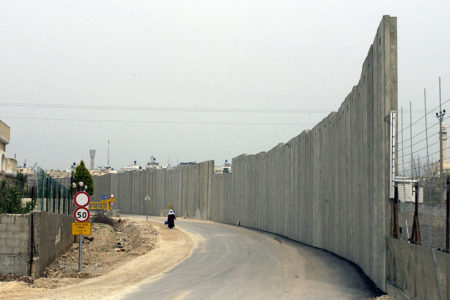Israel: Inside the International Pressure Cooker
Israel has faced many traumas during its 57 years as a small country located at the center of the perennially troubled Middle East. No other modern nation has experienced a war every decade. But tiny Israel has been forced to endure this enormous hardship. And with the expulsion program known as disengagement, the hardship continues.
The world’s only Jewish-run state was born in violent struggle. The 1948 War of Independence began when several Arab countries launched a concerted attack several months before David Ben-Gurion proclaimed Israel’s official appearance on the world map. This was followed by the 1956 Suez conflict, the short and stunning 1967 Six-Day War, the surprise 1973 Yom Kippur assault on Israel by Soviet-backed Syria and Egypt, the 1982 Lebanon war, and the 1991 Iraqi Scud attacks on Israeli coastal cities.
The current decade has been no exception, with the Palestinian al-Aqsa attrition war beginning just two months after Yasser Arafat, then leader of the Palestine Liberation Organization (PLO), rejected Israel’s compromise peace proposal, brokered in July 2000 by U.S. President Bill Clinton at Camp David. In some ways, this conflict—although not universally considered a full war—has been Israel’s toughest protracted battle, producing more Jewish civilian casualties than all the other wars combined.
To make matters worse, the sustained Palestinian terror blitz began just a few years after world leaders joined many Arab and Israeli officials in proclaiming an end to the long regional conflict. Optimism flowed from the Oslo peace accords, signed by Arafat and Israel’s Prime Minister Yitzhak Rabin on the White House lawn in September 1993. But the vaulted “land for peace” process turned out to be “peace, peace, but there is no peace” and poured stinging salt on Israel’s metastasizing, terrorist-inflicted wounds.
The fresh Palestinian violence also led the traumatized Israeli public to turn to a veteran politician whom most commentators had long written off as a potential prime minister—former army general and defense minister, Ariel Sharon. His early 1991 victory over embattled Prime Minister Ehud Barak was followed two years later by a second electoral triumph, this time by a massive landslide over another ex-army general, Labor party leader Amran Mitzna.
Sharon’s U-Turn
Political pundits attributed the overwhelming voter endorsement of Sharon to two main factors: his relative success in dealing with an unprecedented Palestinian terrorist onslaught in 2002 that left more than 100 Israeli civilians dead and hundreds more injured in one month alone, and his firm opposition to yielding to intensifying world demands—accepted by Mitzna’s Labor party—for a quick Israeli evacuation from the densely populated Gaza Strip.
Therefore, it was all the more stunning when the Likud party leader totally reversed course and announced in December 2003 his plans to uproot more than 8,000 Jewish settlers from their homes in the contested Mediterranean coastal zone, along with all Israel Defense Forces (IDF) soldiers stationed there. Adding to the surprise of his bombshell announcement, Sharon added that he would also tear down four Jewish communities in the pristine hills of northern Samaria, located northeast of Tel Aviv near the Arab town of Nablus.
Many top Likud politicians sharply denounced the so-called unilateral disengagement plan, including Sharon’s own finance minister and longtime political nemesis, Benjamin Netanyahu. The U.S.-educated former prime minister argued that a one-sided withdrawal would only reward Arab terror while securing nothing from the Palestinians in return. International approval was not enough to counter the potential negative effects of the proposed pullback, Netanyahu argued, especially if Arab rockets launched from Gaza came crashing down with regularity on Israeli cities after the evacuation was completed.
Sharon’s sudden about-face left many reeling right-wing politicians and voters asking what could have possibly motivated the aging warhorse to completely reverse course and adopt the very Labor party plan he had denounced during the election campaign one year earlier. This was not an idle question, given that no other prime minister had ever ordered a forced removal of Israeli civilians from their homes inside Israel’s ancient heartland.
True, another Likud party leader and longtime Sharon associate, the late Menachem Begin, had uprooted several thousand Jewish people from their homes in the northern Sinai Peninsula as part of the 1979 Egypt-Israel peace accord. But those settlers had resided in Sinai’s dry desert sand dunes for just over 10 years. No one had dared to evacuate Israelis from their homes in the contested Gaza Strip where they had lived for decades, a mere 25 miles south of the country’s main urban area in Tel Aviv. And certainly no other Israeli leader had vowed to order Jews out of their communities in northern Samaria—at the top of the history-soaked spine running through the Jewish people’s biblical homeland.
Ariel Sharon was still a widely respected military commander when Israeli forces captured Jordan’s self-annexed “West Bank” in the lighting 1967 war, including the eastern half of Jerusalem, along with the Egyptian-ruled Gaza Strip and Syria’s Golan Heights. In the nearly four decades since then, he had always stood firm in his insistence that Israel could not evacuate Jewish settlements built in any of those areas in the years following the Six-Day War without gravely endangering the future security of the small state surrounded by hundreds of millions of mostly hostile Muslims.
More than that, the portly politician was the prime mover and shaker behind the establishment of many of the contested settlements. Widely known as the “bulldozer” for his steely tenacity in pursuing his goals, Sharon was the most trusted Likud politician in the nationalistic settler community. That he would end up directing a forced disengagement from 21 Jewish communities in the Gaza Strip and four others in northern Samaria was a sight that very few thought they would ever see.
International Pressure
So what was behind the prime minister’s seeming sudden change of heart? Although many things undoubtedly factored into it, Sharon himself gave the main answer when he presented his unilateral pullout plan to his divided cabinet for the first time in February 2004. The international community would impose crushing economic sanctions upon tiny Israel if a settlement pull-out did not get under way in the near future, he maintained.
Second, Sharon noted that his ministers had previously endorsed the Road Map peace plan, sponsored primarily by the United States and the European Union—Israel’s two main trading partners. It called for the Israeli government to evacuate Jewish settlements in exchange for the Palestinian Authority (PA) disarming and dismantling several terrorist groups, especially Hamas, Islamic Jihad, and the PLO-linked al-Aqsa Martyr’s Brigades.
Even withdrawal skeptics like Netanyahu and Foreign Minister Silvan Shalom could not dispute Sharon’s contention that the tiny Mideast country would face punishing UN-backed economic sanctions if no further land transfers to the Palestinians took place. All realized that such sanctions would be devastating.
However, pullout opponents quickly pointed out there were absolutely no signs that then-PA leader Arafat was making the slightest effort to curb Islamic or PLO terrorism, despite having also officially signed on to the Road Map peace plan. Although there was a temporary spike in hope that the PA would finally do so when Mahmoud Abbas was elected its new leader in January 2005, the facts showed otherwise.
Sharon put forth another crucial argument in trying to secure support for his withdrawal plan from his largely reluctant Likud party. He pointed out that U.S. President George W. Bush had promised in April 2004 to back Israel’s main-stream goal of maintaining full control over at least some of the large Jewish settlements near Jerusalem and Tel Aviv—such as the growing towns of Ariel and Ephrat—as part of any final Israeli-Palestinian peace pact. But he also noted that America’s support hinged on a total Gaza pull-out in 2005 and probably from a few other outlying portions of Judea and Samaria in the future.
Disengagement Turmoil
As the mid-August date for the summer evacuations neared, Israeli public opposition to the unilateral action grew. Opinion polls that had shown at least 60 percent support for the disengagement plan when it was first announced by Sharon revealed that such backing had dropped to barely half of all Israeli voters.
Many said they changed their minds when they realized the Gaza and northern Samaria withdrawals might spark internal dissention bordering on civil war. Others said they reconsidered their initial approval because of the likely prospect that chaos would engulf the Gaza Strip after an Israeli army pullout and growing fears that Hamas would take over the area (more than 1 million Palestinians reside there, many in abject poverty) and use it to fire deadly rockets into nearby Israeli civilian centers.
The loudest complaint voiced by Likud Knesset opponents of the pullout plan—numbering over one-third of the party’s legislators—was that the controversial and divisive proposal was not put to the voters. Many noted that Sharon had promised to hold a referendum when he met with Likud politicians soon after unveiling his plan. “If a majority of Israeli citizens endorse disengagement, then we will accept that and stand down” said Uzi Landau, leader of the anti-pullout Likud camp, who was fired as a cabinet minister, like several others, after voicing his fierce opposition. Landau contended that a nationwide vote was especially necessary since Sharon had run, and won, on a platform that opposed a unilateral Gaza withdrawal.
As the summer began, right-wing charges that Sharon was acting like a third-world dictator became routine. This fueled concerns that the aging premier might be assassinated, as Yitzhak Rabin was 10 years earlier by an anti-Oslo, Israeli Orthodox Jew. While most prominent rabbis spoke out against violent attacks on pro-withdrawal politicians, many also issued rulings that Jewish religious law absolutely forbade the evacuation of Jewish communities inside Israel’s God-given, biblical borders.
With the terror-weary and ever-struggling country of Israel seemingly poised on the edge of a dangerous prec -ipice, a number of prominent Christian leaders in Israel and abroad noted that Sharon had mainly proposed his contentious unilateral pullout plan because of intense international pressure, especially from Europe and the United States. Some warned that if the plan led to an explosion of civil violence inside Israel or to a new wave of Palestinian terror and rocket attacks from the evacuated lands, then world leaders would answer to God for their role in dividing up the Holy Land.
After all, the Lord Himself warned many centuries ago, through the Hebrew prophet Joel, that such a foreign-imposed land division would be one of the main reasons why He will judge the nations at the end of the age (Joel 3:2).







